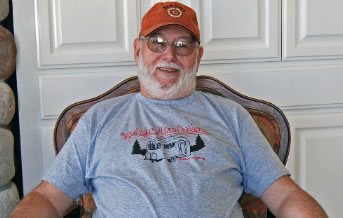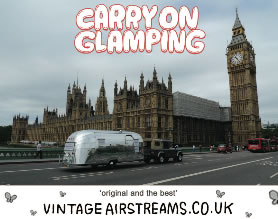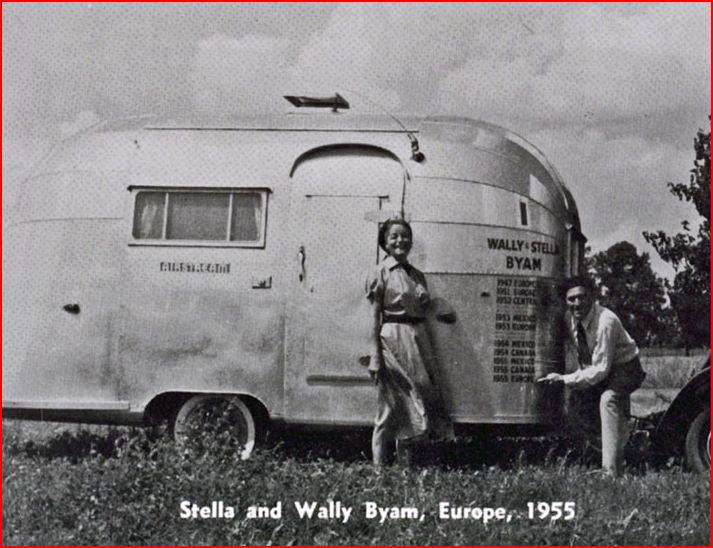Airstream history and Wally Byam
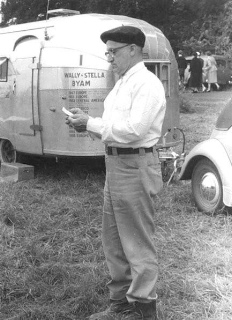
Wally Byam with X251 Bubble 1955 Europe
Wally Byam, airstream’s founder, was practically born a traveler.
As a young child he traveled extensively with his grandfather, who led a mule train in baker,oregon. Later, as an adolescent, he was a shepherd, living in a two-wheeled donkey cart outfitted with a kerosene cook stove, food and water, a sleeping bag and wash pail. these early experiences no doubt contributed in large part to the direction his life would eventually take.
after finishing high school, wally signed on with the merchant marine, serving three years and working his way up from cabin boy to ship’s mate. upon returning to the us, he entered stanford university, working his way through school and, in 1923, earning a law degree.
he never practiced law; perhaps he would never be happy in such a constrained profession. instead, he found work in the rapidly growing advertising business, first as a copywriter for the los angeles times and then as the owner of his own agency.
soon he switched to the opposite side of the street and became a publisher, starting a number of
magazines. one of these, a do-it-yourself magazine, published an article describing plans for the construction of a travel trailer. when readers began complaining about the plans, wally tried them out and found himself agreeing with his readers – the plans were no good.
thereupon, he set out to build his own model, and while he considered it primitive, it was widely admired
and wally began selling sets of plans for five dollars.
soon, in response to demand, he was building improved versions of his trailer in his backyard in los angeles. sales were good. wally’s great innovation was to drop the floor down between the wheels, allowing him to raise the ceiling, making it possible for the campers to stand up straight when inside the trailer.
americans were beginning to take to the roads in greater and greater numbers, and wally’s new trailer was a hit.
the fledgling business survived the crash of 1929, and by 1930 he had abandoned law, advertising and publishing to become a full-time builder of travel trailers.
those first trailers were built of plywood, but he soon switched to masonite and began adding amenities like ice boxes, gasoline stoves and water pumps.
the trailers began to take on a more aerodynamic look as he incorporated aircraft construction methods in order to lessen wind resistance and improve the strength-to-weight ratio of his trailers. in 1934, wally byam introduced the name ‘airstream’, and an american legend was born.
in 1936, the airstream trailer co. introduced the ‘clipper’, with its monocoque, riveted aluminum body, it had more in common with the aircraft of its day than with its predecessors. it could sleep four, thanks to its tubular steel-framed dinette which could convert to a bed, carried its own water supply, had an enclosed galley, and was fitted with electric lights throughout.
the ‘clipper’ boasted of its advanced insulation and ventilation system, and even offered air conditioning that used dry ice.
it was expensive, especially during the depression years, yet the company could not build them fast enough to keep up with the orders that poured in. and the meticulous attention to quality would prove crucial.
of more than 300 trailer builders operating in 1936, only one, airstream, would survive. in 1941 leisure travel and the materials necessary to build trailers both became luxuries the country could not afford.
structural aluminum was classified as a critical war material, available only for the building of vital aircraft. tires and gasoline became scarce. wally byam closed his doors and took his experience with aluminum fabricating first to lockheed, for the duration of the war.
with the war’s end, the economy boomed and consumers began demanding more of the goods they had been deprived of. wally had learned much about aluminum fabrication and design in the aircraft industry, and he was ready to begin applying that knowledge to his trailer concepts.
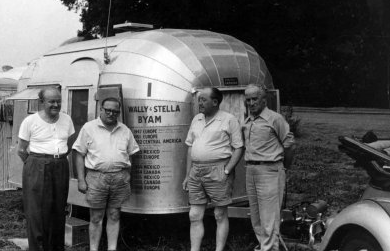
(Wally with Hans Knobel the founder of Westfalia Werke, the family business well know for VW Camper conversions)
for the next ten years, he continued to improve
and refine his products, and the company continued to
prosper and grow.
in 1962, wally byam passed away.
by the early seventies, the popularity of motorhomes had
grown by leaps and bounds. after several years of
development, the first airstream motorhomes were
introduced in 1979.
the original classic motorhome featured riveted aluminum
construction and a monocoque body like the trailer,
and brought a new level of aerodynamic superiority
unavailable in any other motorhome.
in 1989, airstream rolled out the all-new land yacht
motorhome.
in contrast to the classic, this motorhome featured laminated
fiberglass construction and had front and rear end caps so
innovative that a patent was granted for them.
the land yacht was an immediate success and is still the
best-selling airstream motorhome.
an airstream trailer was selected by NASA to house the first
astronauts back from the moon and the motorhomes continue
today to be an integral part of the space shuttle program.
over 60% of all airstreams ever built – including some built
from the original five-dollar plans – are still rolling down the
highways.
(Wally and Stella 1955 with X251)
Please note photos in this section are from the estate of the late Helen Schwamborn
PLEASE THE FOLLOWING WAS EXTRACTED FROM WIKI –
Curtis Wright Industries
Curtis Wright
Made by Curtis Wright Industries’ Aircraft & Trailers (no relationship to the Curtiss-Wright Corporation)
Curtis Wright moved to LA from Michigan before the war to start a manufacturing plant, hired Wally Byam. After the war in 1946, they started production of a new post-war travel trailer based on Wally’s pre-war Airstream Clipper & Silver Cloud models at the LA Metropolitan Airport. After some months they went their separate ways, forming the Airstream Co. and Curtis Wright Travel Trailers. This appears to be why late ’30’s Airstreams and 1940’s Curtis Wright‘s look very similar. In June 1949, three individuals, Kenny Neptune, Frank Pollito and “Pat” Patterson, who had met each other while working for Douglas Aircraft, acquired the trailer business from Mr. Wright and began producing trailers under the Silver Streak name in south El Monte California -which it continued into the 1970’s as a separate company.
Curtiss-Wright manufactured airplanes during the 1940’s, 1950’s. The trailers were made at the Curtis–Wrightfacilities, but a man bearing the name of Curtis Wright (without the extra “s”) took advantage of his name to build trailers, and hired Wally Byam founder of Airstream to continue the Clipper designs. This relationship only lasted for a few months.
Question – What is the relationship between the Curtiss-Wright aviation manufacturer, and the man namedCurtis Wright?
Answer – There is absolutely no connection between NY native world reknown motorcycle racer GlennCurtiss – partner with Orville and Wilbur Wright in Curtiss-Wright Aviation and also inventor of the fifth-wheel hitch and the Curtiss Aerocar (based in Ft Lauderdale, FL) (the first fifth-wheel trailers started in 1917) and Curtis Wright the California manufacturer of Curtis Wright trailers that Wally Byam worked for briefly and using the Airsteam/Bowlus style aluminum segment roof design.
Years built
1946-1949
Models
Model 2, Model 5 Lengths: 16, 22, 27, and 31 foot
Boles-Aero Travel Trailer
History
DON BOLES A dedication to quality
In 1939, Don Boles, an enthusiastic young southern Californian, was one of the first thirty seven candidates chosen for a new four year tool and die apprenticeship program being initiated by the US Department of Labor under President Roosevelt’s plan to assist in bringing the country out of the effects of the Great Depression. He was assigned to work and study at the Lockheed Aircraft Company plant in Burbank, California, where he learned all aspects of aircraft design and construction and how to build tools and component parts. During his time in the program he earned a number of awards for designing and building various tools to enhance the way in which aluminum parts were fabricated.
Following graduation from the apprenticeship program in 1943, and a brief assignment in Cleveland, Ohio, for General Electric Company, he enlisted in the US Navy for the duration of World War II. Following boot camp, he was stationed at a military base in Norman, Oklahoma, and, unable to find available housing for his wife and 3 children, he purchased a used 27-foot trailer to be their home while he served his stint in the Navy.
When he was released from the Navy following VJ Day, he hooked up his trailer and the family took a traveling vacation on their way back to California. When they arrived at their California home, he parked the trailer in his driveway with a “For Sale” sign on it. That very day, the first lookers bought it and actually at a profit for the Boles, but several other customers continued to stop by to attempt to purchase it. Boles quickly recognized the post-war pent-up demand for good trailers so, while reemployed at his civilian job, he began, with his aircraft training, to design an all-riveted, lightweight, all-aluminum top quality trailer. With financial help and moral support from his father, he began to build his first trailer in his single car garage while they searched for a factory site. The residential garage-manufacturing site limited the size of the first trailers to only nine and one half feet in length. They quickly found an available and affordable site and began construction of their trailer factory.
Shortly, a friend of Don’s became interested in the venture, and they formed a partnership as B and R Manufacturing, to build a trailer they dubbed the Roadrunner. Upon completion of the first, garage built, unit, the “For Sale” sign was again applied and this time, the trailer was parked on the street in front of their incomplete factory, next to the mason’s supply of sand and bricks. Once again, the first customer to look at it purchased the trailer for the asking price of $675.00. A neighbor’s father was also impressed with the design and quality of their new products and soon placed an order for 10 trailers to use in his business. He, however, required twelve-foot long units, which would have to wait for the completion of the factory, as they would be too long to build in the family garage where the first units were being built.
The strains of business start-up and factory construction and the related financial problems shortly caused his partner to pull out of their arrangement and Don Boles took full control of the company changing the name to Boles Manufacturing and then renaming the trailer the Boles Aero. As production accelerated, the trailers were so well received that the early problems soon began to fade, and at the end of 1946, the first year in business, over 300 trailers had passed out the doors of the new factory. By this time, the rapid success of the trailer business had eliminated any time or need for Don to maintain another source of employment and he left the outside job he was holding to make ends meet. Production of various models of the Boles Aero high-line travel trailers continued for over thirty years until the company closed its doors for good in 1980. By this time the original nine and twelve-foot models had grown and larger and much more comfortably appointed models from 27 to 35 feet in length were the standards.
In the 1950s, Boles, always active as a promoter of the industry as well as his own products, was instrumental in founding the consumer rally and show that by the mid 1960s became the giant Dodger Stadium trailer show and was for many years the largest RV related event in the World.
Among his contributions to RV design over the years are the flush vent covers for water heaters and furnaces and recessed fillers for water tanks and even door handles so that the exterior lines would be smooth without protruding vents and fillers. These he introduced in the early 1960s and his designs, while upgraded, are still in common use today. Boles also worked with a German manufacturer of small diesel chassis to produce a small front wheel drive diesel “type C” motorhome in the late 1960s when the truck chassis mounted units were just beginning to become popular.
During the Vietnam War, Boles Aero designed and built mobile photo labs that were shipped by giant cargo aircraft to the Far East for use by the US Air Force in developing aerial surveillance camera film, and also mobile medical and dental clinics for civilian use in developing areas.
Don Boles was an active member and multiple term board member of the Los Angeles based Trailer Coach Association, (TCA). He was instrumental in the creation of a separate division of TCA for travel trailer manufacturers. For most of his career he was active in the TCA and of the Chicago based Mobilehome Manufacturers Association as well as a charter member of the American Institute of Travel Trailers, the first association specifically for RV manufacturers and a predecessor to today’s RVIA. He served on the board of directors of the TCA for over 30 years. Boles proved through the years that a well designed, high quality travel trailer could be sold successfully even through the times when many manufacturers were trying to cut costs and prices to the bone in order to “be more competitive”.
From his earliest involvement, Don Boles was a strong proponent of strict industry standards for safety and quality and was instrumental in the lengthy and very political undertaking of getting one set of national standards approved and enforced by the various associations.
For his many contributions to the RV industry over his lengthy career, Don Boles was elected to the RV/MH Hall of Fame as a member of the class of 2005.
copyright 2006 Al Hesselbart
Spartan Travel Trailer and or Mobile Home
History
The Spartan Aircraft Company was founded in 1928 in Tulsa, Oklahoma. The history of Spartan has its roots in oil .Two years before Oklahoma gained statehood in 1905, an oil gusher named the No.1 Ida Glenn sprung up southeast of Tulsa. This gusher turned out to be a giant oil reserve big enough to establish future companies such as Getty, Gulf, Standard Oil, (now Exxon), Sinclair and Skelly. The teens and twenties were a time of great opportunities. America was moving into the “modern” era. There were many new technologies being introduced and perfected: the automobile, electricity, and airplane flight were among a few. Oil and the internal combustion engine played a major role in these technologies. Oil companies had a great interest in these new products. William G Skelly founder of the Skelly Oil Company came to be known as “Mr. Tulsa”. In the 1920’s he turned his business into one of the world’s largest independent oil companies. He was one of the wealthiest men in the country and was very aware of the “modern” America and its new technologies. Skelly had a great interest in aeronautics. The Skelly Oil Company sponsored both The Air Adventures of Jimmie Allen and Captain Midnight. Both Series based around aviation. Skelly’s wealth allowed him to pursue this interest by his founding of the Spartan Aircraft Company which was started as an aeronautical college and airplane manufacturer In the late 1930’s Spartan was acquired by the Getty Corporation owned by the famous billionaire and oil tycoon J. Paul Getty. At the end of the W.W.II the Spartan factory was beefed up due to wartime production. Getty had to decide where he was going to take the company next. A product he could market to a large audience was needed. His engineers were busy with several exciting projects. A 5-passenger airplane prototype was completed and flown. Whose performance surpassed expectations and would be the best plane the company had ever built. In addition to this new plane they were also working on a new type automobile and a radically designed travel trailer. Due to the war the competition in airplane manufacturing had risen greatly. Top management figured the cost in dollars and length of time before there new plane design could be in production and producing supply for inventory would be to great an expense. As far as automobile manufacturing went the cost of retooling would be out of the question and this was too much of a departure from what they new best. With the great need for housing after the war Getty determined that trailer manufacturing would be the way to go. The first prototype was made in the summer of 1945 using aircraft design similar to the Spartan Executive without much concern for other trailers trailer design of the time. They were out to produce the best product on the market. Using building techniques and designs that they had mastered in the aircraft building industry. By mid 1945 the pilot model had been completely road tested and a small production run of 100 was scheduled. G.R. Schutes, a designer of national reputation, had been hired to give the trailers a modern look incorporating many deco design elements. True to there intent Spartan spared no expense on there trailers. They were of the highest quality and sleekest design employing the monocoque building technique used in airplane manufacturing. They were truly the “Cadillac” of trailers. When we compare the price of a brand new home in Levittown for under $8000 including the land the 25 foot Spartan Manor at close to $4000 was rather expensive. The first models rolling off the production line in the mid 40’s to early 50’s could be considered true travel trailers in every since with the largest reaching around 35 feet long. As the interstate highway system began to come into existence things would change. The company started making much larger trailers, or homes as Spartan preferred to call them. They were furnished in the latest of styles from couches to window coverings. The 50’s saw a great rise in the number of competing trailer manufacturing companies. Most offering models priced much below that of Spartan. In 1958, to stay competitive, Spartan introduced 2 new lines of trailers. The “Sparcraft” an all aluminum and riveted trailer constructed with less appealing styling than the Spartan ie: no compound curves lower grade aluminum and more conservative interiors of lessor quality. There super economy line the “Sparlane” was a basic boxy affordable mobile home. 1959 marked the final year of production. At this time Spartan had a very extensive line of trailers with 19 models. The largest reaching 10 feet wide by 50 feet long. A fleet of 29 2-ton Internationals was used to deliver these large homes. Among this line up Spartan introduced the “Crescendo” and the “Carousel” two trailers with ultra modern 50’s styling and never before seen curving floorplans. Sadly this would be the last of the Spartans produced.In 1961 the plant closed and the company went into the insurance and financial business, under the name of the Minnehoma Insurance Co., After closing its plant, Spartan sold its name to the Spartan School of Aeronautics, which continues today. (www.spartantrailer.com)
Aircraft Quality, Nifty Interiors
The enterprising J.P. Getty saw a need, in the post-World War II era, for affordable yet high-quality housing. The Spartan Trailer, utilized for either recreation or primary living space depending upon the model and the needs of the owner, helped to fill this niche. Getty’s familiarity with manufacturing materials and laudable success running the Spartan factory’s war-effort fabrication of entire craft such as the Navy NP-1 trainer or components for B-24 bombers gave him ability and inspiration for creating these trailers. He knew of the durability of aircraft-grade aluminum and other materials, and insisted upon their use in the construction of the Spartan Trailer.
Bowlus Travel Trailer
History
Bowlus was the first all aluminum travel trailer designed by Hawley Bowlus in 1934. The trailer is an ultra-light one weighing only about 1100 lbs. It is made of panels of riveted alclad aluminum that is screwed to a galvanized steel tubing that is acetylene welded together. This constuction method was very similar to the way aircraft were constructed.
“The pleasures of touring and camping and seeing nature at her best has instilled a wanderlust into the hearts of so vast a number of our people that the demand for comfort in this national pastime has reached a point that has engaged the attention of men rich in the knowedge of construction on proven lines gathered thru experience in the aircraft industry, as well as the auto industry. “No longer need we wait for years of experimentation that has characterized the automotive industry, but profiting by years of experience we wish to introduce you to the outstanding features of the BOWLUS ROAD CHIEF.” – Bowlus Road Chief brochure
BOWLUS – TELLER TRAILER as pictured in Popular Machanics Magazine January, 1937
Manufacturer Information
The Soaring Connection Legendary glider pilot and builder Wm. Hawley Bowlus built some rather famous aircraft during his career.
Among these were:
The Spirit of St. Louis. Bowlus was the shop foreman at Mahoney-Ryan Airlines, in San Diego, California, and supervised the 1927 construction of Charles Lindbergh’s famous trans-Atlantic airplane.
Bowlus’ sailplane #16, built in San Diego, California (1930), is commonly known as the Paper Wing on account of his using kraft paper for his wing rib shear web.
Bowlus’ S-1000 and Model A series of sailplanes, also built in San Diego. Both of these two serieses resembled the Paper Wing but had conventional “stick & gussett” ribs. Bowlus broke the one hour duration record (eventually to more than 9 hours) flying a S-1000 along Pt. Loma, in San Diego. Bowlus’ friends Charles and Anne Lindbergh flew Model As.
The Bowlus-duPont “Senior Albatross” series of sailplanes. These were the first true sailplanes to be built in the US, and were built in San Fernando, California in 1933 & ’34. Of this four glider series, three were built for Richard (Dick) duPont and one for SSA founder Warren Eaton. The Albatross I was used by duPont to win the US Nationals in 1934 and to set a World Distance Record in 1935. The Albatross II was used by duPont to set a World Distance Record in 1934, and Lewin Barringer used it to place 2nd in the 1934 US Nationals. I own the Albatross II, which is currently under restoration.
Bowlus’ Baby Albatross sailplane, which was one of the first kit-built gliders offered to the soaring public. Approximately 100 kits were produced in San Fernando from 1936 to 1941. This pod & boom glider is often called “cute.”
The Bowlus-Nelson Dragonfly, built in San Fernando in 1945, was one of the first motorgliders built in the US.
Everyone has a hobby, and Bowlus’ was building scale-model live steam trains and was associated with the Los Angeles Live Steamers. His trains plied the tracks of Travel Town in LA’s Griffith Park for many years, bringing delight to the thousands of children and adults who rode on them.
Founder of Vintage Airstreams, Sam Harkness before his first birthday.
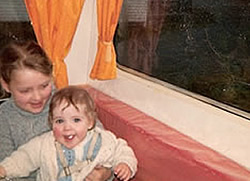
Wally Byam’s Creed
“In the heart of these words is an entire life’s dream. To those of you who find in the promise of these words your promise, I bequeath this creed… my dream belongs to you.”
To place the great wide world at your doorstep for you who yearn to travel with all the comforts of home.
To provide a more satisfying, meaningful way of travel that offers complete travel independence, wherever and whenever you choose to go or stay.
To keep alive and make real an enduring promise of high adventure and faraway lands… of rediscovering old places and new interests.
To open a whole world of new experiences… a new dimension in enjoyment where travel adventure and good fellowship are your constant companions.
To encourage clubs and rallies that provide an endless source of friendships, travel fun and personal expressions.
To lead caravans wherever the four winds blow… over twinkling boulevards, across trackless deserts… to the traveled and untraveled corners of the earth.
To play some part in promoting international goodwill and understanding among the peoples of the world through person-to-person contact.
To refine and perfect our product by continuous travel-testing over the highways and byways of the world.
To strive endlessly to stir the venturesome spirit that moves you to follow a rainbow to its end… and thus make your travel dreams come true.
– Wally Byam
Cape town to Cario caravan special feature, sit back and enjoy the ride –
1 of 5
2 of 5
3 of 5
4 of 5
5 of 5
Interview with Pee Wee (Dale) on Cape Town to Cario caravan –
We hoped you enjoyed this footage, just amazing.
We need your help, we would like to bring Pee Wee (aka Dale) to Europe and need your donations please. Even you if are based in the states, please take a moment to pledge a little towards this trip. Please email us to request more information.
For the most complete history please visit a site created by Dale (Pee Wee) Schwamborn the first cousin once removed of Wally
Get In Touch
+44 (0)7766 704 896+44 (0)7766 704 896
info@vintageairstreams.co.uk
Vintage Airstreams Wanted to buy - Top dollar paid.
We purchase via our a New York State company.

Dale "Pee Wee" Schwamborn, A relative of Wally Byam and his close friend who travelled on many caravans with Wally. Nice T-Shirt Pee Wee! -
